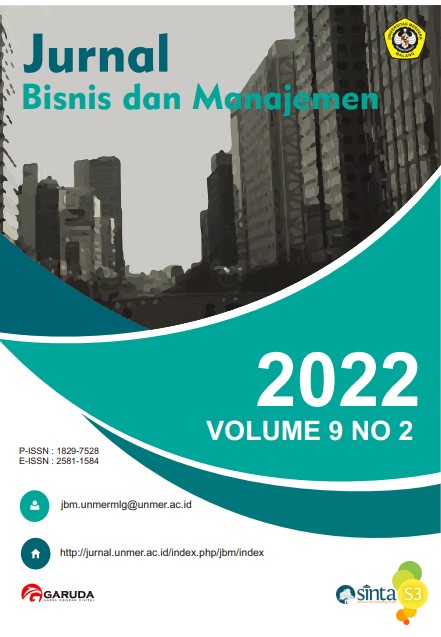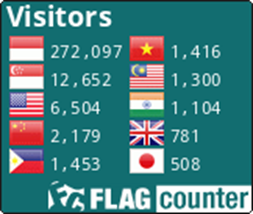Implementasi Social-Bricolage Entrepreneurship dan Digital Marketing sebagai Strategi Resiliensi Pelaku Program Pekarangan Pangan Lestari
DOI:
https://doi.org/10.26905/jbm.v9i2.8722Keywords:
Social-Bricolage Entrepreneurship, Digital Marketing, Resilience Strategy, Pekarangan Pangan Lestari (P2L)Abstract
This study aims to examine the effect of P2L program (social-bricolage entrepreneurship) on P2L business performance and to examine the role of digital marketing as mediating effect of social-bricolage entrepreneurship on P2L business performance. This research is explanatory research with a quantitative approach. The sample in this study is the manager/member of the P2L program group in Malang Regency and collected as many as 62 respondents from 30 P2L groups. Data analysis used the SEM-PL. The research findings show that social-bricolage entrepreneurship does not have a significant effect on the business performance of P2L group managers/members, but has a major impact on the use of digital marketing strategies so as to improve performance. This finding means that digital marketing has a full mediation role in the relationship between social-bricolage entrepreneurship and P2L business performance. In addition to explaining this relationship, this research also shows the need to frame the role of digital marketing within this framework, so that it can provide maximum benefits. Given this important role, managers/members of the P2L group should make maximum use of the existing digital platforms, both freely available and with support from relevant stakeholders.
Downloads
References
Akbar, A. K., Yusra, A. H. A., & Dewi, Y. S. K. (2018). Dampak Program Kawasan Rumah Pangan Lestari Terhadap Pendapatan Dan Pengeluaran Pangan Di Kabupaten Mempawah. SOCIAL ECONOMIC OF AGRICULTURE, 7(1), 9–17.
Ashari, N. F. N., Saptana, S., & Purwantini, T. (2016). Potensi dan Prospek Pemanfaatan Lahan Pekarangan untuk Mendukung Ketahanan Pangan. Forum Penelitian Agro Ekonomi, 30, 13. https://doi.org/10.21082/fae.v30n1.2012.13-30
Baker, T., & Nelson, R. (2005). Creating Something From Nothing: Resource Construction Through Entrepreneurial Bricolage. Administrative Science Quarterly, 50, 329–366. https://doi.org/10.2189/asqu.2005.50.3.329
Barney, J. B. (1991). Firm Resources and Sustained Competitive Advantage. Journal of Management, 17(1), 99–120.
Chaffey, D., & Smith, P. (2013). Emarketing Excellence: Planning and Optimizing Your Digital Marketing (Fourth edi). Routledge.
Chang, Y.-C., Ku, C.-H., & Chen, C.-H. (2019). Social media analytics: Extracting and visualizing Hilton hotel ratings and reviews from TripAdvisor. International Journal of Information Management, 48, 263–279. https://doi.org/https://doi.org/10.1016/j.ijinfomgt.2017.11.001
Chen, S.-C., & Lin, C.-P. (2019). Understanding the effect of social media marketing activities: The mediation of social identification, perceived value, and satisfaction. Technological Forecasting and Social Change, 140, 22–32. https://doi.org/https://doi.org/10.1016/j.techfore.2018.11.025
Chen, Y. S., Lai, S. B., & Wen, C. T. (2006). The influence of green innovation performance on corporate advantage in Taiwan. Journal of Business Ethics, 67(4), 331–339.
Cheung, C. W. M., Kwong, C., Manzoor, H., Rashid, M. U., Bhattarai, C., & Kim, Y.-A. (2019). The co-creation of social ventures through bricolage, for the displaced, by the displaced. International Journal of Entrepreneurial Behavior & Research, 25(5), 1093–1127. https://doi.org/10.1108/IJEBR-03-2018-0140
Cooper, P. (2020). 43 Social Media Advertising Stats that Matter to Marketers in 2020. Https://Blog.Hootsuite.Com/.
Cucculelli, M., & Peruzzi, V. (2020). Innovation over the industry life-cycle. Does ownership matter? Research Policy, 49(1), 103878. https://doi.org/10.1016/j.respol.2019.103878
Di Domenico, M., Haugh, H., & Tracey, P. (2010). Social Bricolage: Theorizing Social Value Creation in Social Enterprises. Entrepreneurship Theory and Practice, 34(4), 681–703. https://doi.org/10.1111/j.1540-6520.2010.00370.x
Ghozali, I., & Latan, H. (2015). Partial least squares konsep, teknik dan aplikasi menggunakan program smartpls 3.0 untuk penelitian empiris. Semarang: Badan Penerbit UNDIP.
Gundry, L. K., Kickul, J. R., Griffiths, M. D., & Bacq, S. C. (2011). Creating Social Change Out of Nothing: The Role of Entrepreneurial Bricolage in Social Entrepreneurs’ Catalytic Innovations. In G. T. Lumpkin & J. A. Katz (Eds.), Social and Sustainable Entrepreneurship (Vol. 13, pp. 1–24). Emerald Group Publishing Limited. https://doi.org/10.1108/S1074-7540(2011)0000013005
Habibi, M. R., Laroche, M., & Richard, M.-O. (2014). Brand communities based in social media: How unique are they? Evidence from two exemplary brand communities. International Journal of Information Management, 34(2), 123–132. https://doi.org/https://doi.org/10.1016/j.ijinfomgt.2013.11.010
Hardilawati, W. L. (2019). Model Pemasaran Hubungan Pelanggan, Inovasi dan E-Commerce dalam Meningkatkan Kinerja Pemasaran UKM Di Pekanbaru. Jurnal Akuntansi Dan Ekonomika, 9(2), 213–222.
Hendrawan, D., & Zorigoo, K. (2019). Trust in Website and Its Effect on Purchase Intention for Young Consumers on C2C E-Commerce Business. Jurnal Aplikasi Manajemen, 17(3), 391–399. https://jurnaljam.ub.ac.id/index.php/jam/article/view/1526
Henseler, J., Ringle, C., & Sarstedt, M. (2015). A New Criterion for Assessing Discriminant Validity in Variance-based Structural Equation Modeling. Journal of the Academy of Marketing Science, 43, 115–135. https://doi.org/10.1007/s11747-014-0403-8
Ihya, H., & Hijri, Y. S. (2020). Group Empowerment Trough Kawasan Rumah Pangan Lestari (KRPL) in Karangbesuki Village, Malang City. Journal of Local Government Issues LOGOS, 3(1), 18–36.
Islami, N. W., & Khouroh, U. (2021). Analisis Faktor-Faktor yang Mempengaruhi Balita Stunting dan Tantangan Pencegahannya pada Masa Pandemi. KARTA RAHARDJA: Jurnal Pembangunan Dan Inovasi, 3(2), 6–19. https://ejurnal.malangkab.go.id/index.php/kr/article/view/49/29
Kamboj, S., Sarmah, B., Gupta, S., & Dwivedi, Y. (2018). Examining branding co-creation in brand communities on social media: Applying the paradigm of Stimulus-Organism-Response. International Journal of Information Management, 39, 169–185. https://doi.org/https://doi.org/10.1016/j.ijinfomgt.2017.12.001
Khouroh, U., Abdullah, F., & Handayani, K. (2019). The role of strategic alliance in mediating the relationship between environmental dynamism and sustainable competitive advantage. International Journal of Scientific & Technology Research, 8(9), 469–475.
Khouroh, U., Ratnaningsih, C. S., & Rahayudi, B. (2021). Inovasi dan Daya Saing UMKM di Era New Normal: dari Triple Helix Model ke Quadruple Helix Model. Jurnal Manajemen Dan Kewirausahaan, 9(2), 152–162.
Khouroh, U., Sudiro, A., Rahayu, M., & Indrawati, N. K. (2020). The mediating effect of entrepreneurial marketing in the relationship between environmental turbulence and dynamic capability with sustainable competitive advantage: An empirical study in Indonesian MSMEs. Management Science Letters, 10, 709–720.
Khouroh, U., Windhyastiti, I., & Handayani, K. (2019). Peran Kebijakan Pemerintah dalam Memperkuat Aliansi Strategis dan Meningkatkan Daya Saing Ekonomi Kreatif. Jurnal Manajemen Dan Kewirausahaan, 7(2), 205–224.
Ko, E. (2019). Bridging Asia and the world: Global platform for the Interface between marketing and management. Journal of Business Research, 99, 350–353. https://doi.org/https://doi.org/10.1016/j.jbusres.2018.12.061
Kraus, S., Clauss, T., Breier, M., Gast, J., Zardini, A., & Tiberius, V. (2020). The economics of COVID-19 : initial empirical evidence on how family firms in five European countries cope with the corona crisis. International Journal of Entrepreneurial Behavior & Research, 26(5), 1067–1092. https://doi.org/10.1108/IJEBR-04-2020-0214
Labrecque, L. I., vor dem Esche, J., Mathwick, C., Novak, T. P., & Hofacker, C. F. (2013). Consumer Power: Evolution in the Digital Age. Journal of Interactive Marketing, 27(4), 257–269. https://doi.org/https://doi.org/10.1016/j.intmar.2013.09.002
Lamberton, C., & Stephen, A. T. (2016). A Thematic Exploration of Digital, Social Media, and Mobile Marketing: Research Evolution from 2000 to 2015 and an Agenda for Future Inquiry. Journal of Marketing, 80(6), 146–172. https://doi.org/10.1509/jm.15.0415
Laroche, M., Habibi, M. R., & Richard, M.-O. (2013). To be or not to be in social media: How brand loyalty is affected by social media? International Journal of Information Management, 33(1), 76–82. https://doi.org/https://doi.org/10.1016/j.ijinfomgt.2012.07.003
LeÌvi-Strauss, C. (1966). The savage mind. The University of Chicago Press.
Linna, P. (2013). Bricolage as a means of innovating in a resource-scarce environment: A study of innovator-entrepreneurs at the BOP. Journal of Developmental Entrepreneurship (JDE), 18(03), 1–23.
Liu, L., Lee, M. K. O., Liu, R., & Chen, J. (2018). Trust transfer in social media brand communities: The role of consumer engagement. International Journal of Information Management, 41, 1–13. https://doi.org/https://doi.org/10.1016/j.ijinfomgt.2018.02.006
Liu, S., Perry, P., & Gadzinski, G. (2019). The implications of digital marketing on WeChat for luxury fashion brands in China. Journal of Brand Management, 26(4), 395–409. https://doi.org/10.1057/s41262-018-0140-2
Mandal, P. (2016). Understanding Digital Marketing - Theories and Strategies. International Research Journal of Management Science and Technology, 7(9), 50–60.
MartÃn-Consuegra, D., Faraoni, M., DÃaz, E., & Ranfagni, S. (2018). Exploring relationships among brand credibility, purchase intention and social media for fashion brands: A conditional mediation model. Journal of Global Fashion Marketing, 9(3), 237–251. https://doi.org/10.1080/20932685.2018.1461020
Mayr, S., Mitter, C., & Aichmayr, A. (2016). Corporate Crisis and Sustainable Reorganization : Evidence from Bankrupt Austrian SMEs. Journal of Small Business Management, 55(1), 108–127. https://doi.org/10.1111/jsbm.12248
Musona, J., Sjögrén, H., Puumalainen, K., & Syrjä, P. (2020). Bricolage in environmental entrepreneurship: How environmental innovators “make do†at the bottom of the pyramid. Business Strategy & Development, 3. https://doi.org/10.1002/bsd2.112
Pacauskas, D., Rajala, R., Westerlund, M., & Mäntymäki, M. (2018). Harnessing user innovation for social media marketing: Case study of a crowdsourced hamburger. International Journal of Information Management, 43, 319–327. https://doi.org/https://doi.org/10.1016/j.ijinfomgt.2018.08.012
Pamungkasih, E., Sukardi, & Julijanti, F. D. (2021). Analisis Tingkat Ketahanan Pangan Keluarga Bagi Masyarakat Terdampak Covid-19 Di Kabupaten Malang. KARTA RAHARDJA: Jurnal Pembangunan Dan Inovasi, 2(1), 18–26.
Papadopoulos, T., Baltas, K. N., & Balta, M. E. (2020). The use of digital technologies by small and medium enterprises during COVID-19 : Implications for theory and practice. International Journal of Information Management, 55(Desember), 1–4. https://doi.org/10.1016/j.ijinfomgt.2020.102192
Peredo, A. M., & Chrisman, J. J. (2006). Toward a Theory of Community-Based Enterprise. The Academy of Management Review, 31(2), 309–328. https://doi.org/10.2307/20159204
Porter, M. E. (1991). The Competitive Advantage of Nations. In Harvard Business Review. https://doi.org/10.1007/978-1-137-28787-8_72
Rapaccini, M., Saccani, N., Kowalkowski, C., Paiola, M., & Adrodegari, F. (2020). Navigating disruptive crises through service-led growth : The impact of COVID-19 on Italian manufacturing firms. Industrial Marketing Management, 88(May), 225–237. https://doi.org/10.1016/j.indmarman.2020.05.017
Roberton, T., Carter, E. D., Chou, V. B., Stegmuller, A. R., Jackson, B. D., Tam, Y., Sawadogo-Lewis, T., & Walker, N. (2020). Early estimates of the indirect effects of the COVID-19 pandemic on maternal and child mortality in low-income and middle-income countries: a modelling study. The Lancet Global Health, 8(7), e901–e908. https://doi.org/10.1016/S2214-109X(20)30229-1
Senyard, J., Baker, T., Steffens, P., & Davidsson, P. (2014). Bricolage as a path to innovativeness for resource-constrained new firms. Journal of Product Innovation Management, 31(2), 211–230. https://doi.org/10.1111/jpim.12091
Setyorini, D., Nurhayaty, E., & Rosmita, R. (2019). Pengaruh Transaksi Online (e-Commerce) terhadap Peningkatan Laba UMKM (Studi Kasus UMKM Pengolahan Besi Ciampea Bogor Jawa Barat). Jurnal Mitra Manajemen, 3(5), 501–509.
Shanahan, T., Tran, T. P., & Taylor, E. C. (2019). Getting to know you: Social media personalization as a means of enhancing brand loyalty and perceived quality. Journal of Retailing and Consumer Services, 47, 57–65. https://doi.org/https://doi.org/10.1016/j.jretconser.2018.10.007
Suryo, B. (2021). Pemkab Malang Garap Desa Stunting dan Rawan Pangan Bersamaan. Mediaindonesia.Com. https://mediaindonesia.com/nusantara/410900/pemkab-malang-garap-desa-stunting-dan-rawan-pangan-bersamaan
Tafesse, W., & Wien, A. (2018). Implementing social media marketing strategically: an empirical assessment. Journal of Marketing Management, 34(9–10), 732–749. https://doi.org/10.1080/0267257X.2018.1482365
Thompson, J. (2008). Social Enterprise and Social Entrepreneurship: Where Have We Reached? A Summary of Issues and Discussion Points. Social Enterprise Journal, 4, 149–161. https://doi.org/10.1108/17508610810902039
Thorpe, H. (2018). Creating an integrated digital marketing strategy: Using cross-channel data to build intelligent strategies. Ournal of Digital & Social Media Marketing, 6(1), 28–39.
Tuten, T. L., & Solomon, M. R. (2017). Social media marketing. Sage.
United Nations Children’s Fund, World Health Organiztion, & World Bank Group. (2021). Levels and trends in child malnutrition: UNICEF/WHO/The World Bank Group joint child malnutrition estimates: key findings of the 2021 edition. https://www.who.int/publications/i/item/9789240025257
Xu, X., Wang, X., Li, Y., & Haghighi, M. (2017). Business intelligence in online customer textual reviews: Understanding consumer perceptions and influential factors. International Journal of Information Management, 37(6), 673–683. https://doi.org/https://doi.org/10.1016/j.ijinfomgt.2017.06.004
Yasmin, A., Tasneem, S., & Fatema, K. (2015). Effectiveness of Digital Marketing in the Challenging Age: An Empirical Study. International Journal of Management Science and Business Administration, 1(5), 69–80.
Zahra, S. A., Gedajlovic, E., Neubaum, D. O., & Shulman, J. M. (2009). A typology of social entrepreneurs: Motives, search processes and ethical challenges. Journal of Business Venturing, 24(5), 519–532. https://doi.org/https://doi.org/10.1016/j.jbusvent.2008.04.007
Zhang, M., Guo, L., Hu, M., & Liu, W. (2017). Influence of customer engagement with company social networks on stickiness: Mediating effect of customer value creation. International Journal of Information Management, 37(3), 229–240. https://doi.org/https://doi.org/10.1016/j.ijinfomgt.2016.04.010
Downloads
Published
How to Cite
Issue
Section
License
Authors who publish with this journal agree to the following terms:
(1) Copyright of the published articles will be transferred to the journal as the publisher of the manuscripts. Therefore, the author confirms that the copyright has been managed by the journal.
(2) Publisher of Jurnal Bisnis dan Manajemen is University of Merdeka Malang.
(3) The copyright follows Creative Commons Attribution–ShareAlike License (CC BY SA): This license allows to Share — copy and redistribute the material in any medium or format, Adapt — remix, transform, and build upon the material, for any purpose, even commercially.














